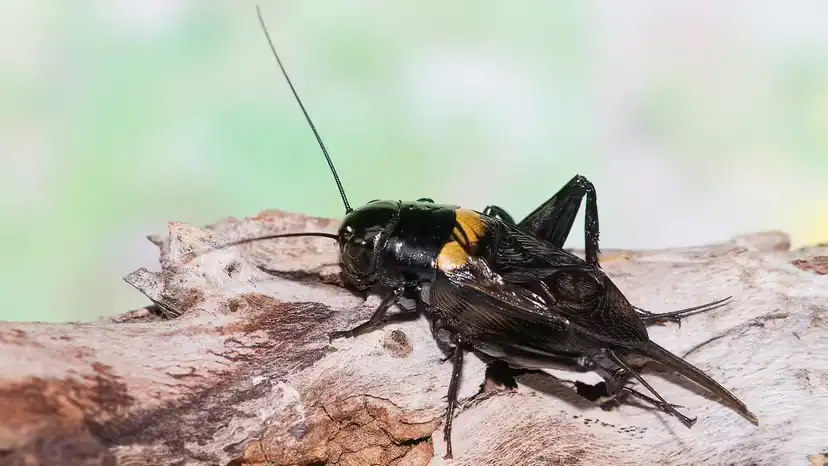TL;DR: Crickets are omnivorous scavengers. In the wild they consume fresh plant matter, decaying vegetation, fungi, and dead/soft-bodied insects. In captivity, offer a balanced mix of greens, moisture-rich produce, quality insect diet, and calcium/vitamins, with safe hydration and good ventilation. For reptiles, gut-load crickets 24–48 hours before feeding.

Crickets thrive by eating “a little of everything,” which helps them survive in grasslands, woodlands, gardens, and even caves.
Plant matter: tender leaves, grass seeds, flower petals, fruit scraps, crop residues
Animal matter: dead insects, soft-bodied larvae, occasional small invertebrates
Detritus & fungi: decaying leaves/twigs, molds, mosses, and other organic debris
Preference shift: When moisture is abundant, crickets favor juicy fruits/greens; during scarcity, they pivot to higher-protein options like carrion and larvae.
Why it matters: This varied diet makes crickets decomposers and incidental pest suppressors (e.g., nibbling aphids/larvae), recycling nutrients back into soils and sustaining birds, reptiles, amphibians, and small mammals.
Variety beats monotony: Blend plant foods + protein + minerals. Don’t rely on cat/dog food alone.
Moisture matters: Water-rich produce dramatically reduces dehydration deaths.
Small amounts, more often: Limits spoilage, mold, and mites.
Greens & produce (base): kale, collards, romaine hearts, dandelion greens, carrot coins, squash, apple/pear slices, citrus segments, watermelon rinds (thin pieces).
Complex carbs & fiber (optional): quick oats, cracked corn, wheat bran (pinches).
Protein (sparingly): commercial insect or orthopteran diets, high-quality fish food in tiny amounts, boiled egg white crumbs, ground dried mealworm (light dusting).
Minerals/vitamins: reptile calcium powder and a broad multivitamin 1–2× per week (light dust).
Water delivery: shallow lids with cotton balls/sponge (prevents drowning) or water gel.
Humidity target: 40–60%; higher levels raise mold/mite risk.
Ventilation: generous cross-vent holes; keep a dry zone and remove leftovers within 24 hours.
Salty/sugary/oily human foods and seasonings
Onion/garlic/chives and strong essential-oil herbs (mint, rosemary)
Unwashed produce peels (pesticide risk)
Long-term single-source diets (e.g., only cat food)
“Gut-loading” means feeding crickets nutrient-dense foods for 24–48 hours before they’re offered to reptiles/amphibians—boosting calcium, vitamins, and carotenoids delivered to your animal.
Sample 24–48h Gut-Load Menu
Dark leafy green + carrot/squash
High-quality insect chow (protein)
Light dusting of calcium and a multivitamin (per your reptile’s schedule)
Before serving: a light dust on the crickets improves Ca:P balance for many reptiles. Adjust frequency by species/age (e.g., juveniles and breeders often need more frequent supplementation).

| Type | Typical note | Feeding/Environment tip |
|---|---|---|
| House crickets (Acheta domesticus) | Most common feeder species; like warmth | Thrive at 28–32°C (82–90°F); offer moist produce + insect chow for high survival |
| Field crickets | Louder callers; very active | Slightly higher protein tolerance; keep rations small and fresh |
| Cave/Camel (spider) crickets | Prefer dimmer, cooler, slightly damp spots | Watch humidity closely; prioritize produce for water, strong airflow to curb mold |
Temperature note: Below 20°C / 68°F, activity drops and mortality rises; keep warm for breeding/vigorous colonies.
Decomposition: Shred and consume leaf litter & carrion, accelerating nutrient cycling.
Incidental pest control: Will sample aphids/larvae where available.
Food-web keystone: Feed a wide array of wildlife—plus serve as feeder insects for pets.
Ventilated tub/terrarium with secure lid
Warm zone (aim 75–90°F / 24–32°C, species-dependent)
Two feeding zones: moist produce & dry chow
Safe water (cotton/sponge or gel)
Hide pieces (egg cartons) to reduce cannibalism
Daily spot-clean; 24h leftover removal
Low-density housing to cut stress and cannibalism
What do crickets eat in the wild?
A mix of fresh/decaying plant matter, fungi, dead insects, and larvae—whatever is available.
Can I feed pet crickets only cat or dog food?
Not recommended long term. Add greens/produce, a quality insect diet, and calcium/vitamins for balance.
How long should I gut-load crickets?
Typically 24–48 hours before feeding to your reptile or amphibian.
Why are my crickets dying?
Common causes: dehydration, poor ventilation, moldy food, overcrowding, low temps. Fix environment first.
Do crickets need water? Won’t they drown?
Yes, they need water. Offer it via cotton/sponge or gel to prevent drowning.
animal tags: Crickets
We created this article in conjunction with AI technology, then made sure it was fact-checked and edited by a Animals Top editor.